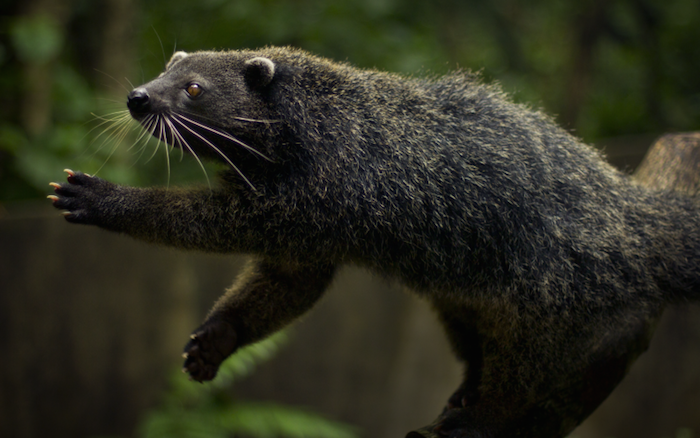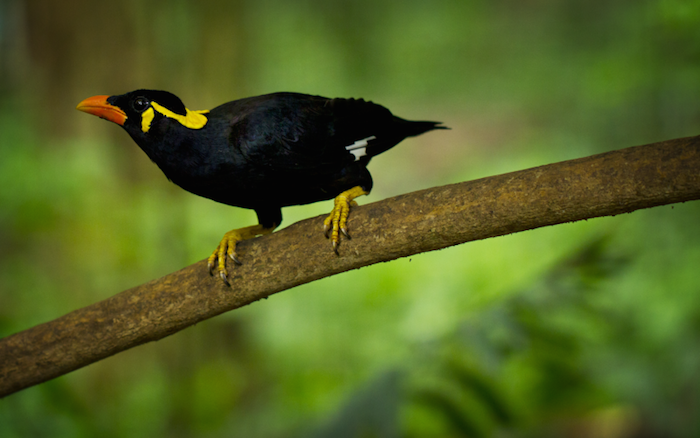As a globe-trotting conservation filmmaker, Katie Schuler has always had her eye on the Philippines. The tropical terrain brims with rare animals: There’s the tarsier, a tiny primate who curls up in moss trees and watches his surroundings with alien-esque eyes that shine like enormous marbles. The sleek black myna stands out from the country’s 657 bird species because it has mimicking abilities so sophisticated, it can imitate a cell phone ring. Binturongs, or “bearcats,” flop their heavy, fur-coated bodies across wide branches and bask in the sun, but when they become agitated, they sweat from a gland that emits the unmistakable odor of popcorn.
Ms. Schuler, a 2007 Corcoran alumna, has come across exotic creatures endemic to the Philippines through an environmental storytelling project she’s working on as part of the Luce Scholars Program, a nationally competitive fellowship that brings young Americans to Asian countries. The George Washington University nominated her for the program last year.
She has been a professional photographer and videographer for more than a decade, mastering the art of visual storytelling. She’s traveled to almost 20 countries, and her clients have included National Geographic, the Smithsonian Institute, Conservation International and PBS. Trained as a fine artist, Ms. Schuler works in nearly every medium, often changing media to best fit her clients' storytelling needs. Her work has garnered recognition within the filmmaking community, including a nomination for the “best animation” award during the 2012 Blue Ocean Film Festival.

The female binturong is thought to have the ability to alter its due date based on environmental conditions. Photo by Katie Schuler.
With its location at the highest point of the Coral Triangle, the Philippines boasts some of the world’s most extraordinary biodiversity. However, many of its marine protected areas are not well maintained, a problem exacerbated by wildlife trafficking and ineffective environmental laws. Ms. Schuler wanted to participate in the Luce fellowship program to use her video, photo and artistic skills to bring attention to marine conservation.
"I saw the Philippines as an epicenter of biodiversity and marine life, but I wanted to explore Filipinos' relationships to nature in order to better understand their conservation challenges and find opportunities to improve local awareness of the natural resources right in their own backyard,” she said.
There was one problem: She couldn’t apply for the fellowship through her alma mater, the Corcoran College, because the school wasn’t a partnering institution of the Luce Foundation. Luckily, just blocks away, GW could help—the university is a community nominator that connects individuals from D.C. to the program.
She arranged a visit with GW’s Center for Undergraduate Fellowships and Research in 2011 and explained her project proposal to the office’s director, Paul Hoyt-O’Connor. Dr. Hoyt-O’Connor browsed her portfolio and thought of his teenage daughter, who would love Ms. Schuler’s dynamic photos. People would instantly be attracted to Ms. Schuler’s work, Dr. Hoyt-O’Connor knew, so nominating her for the program was a no-brainer.
“Her body of work was really colorful and engaging, and it was easy for me to imagine young people interacting with it,” Dr. Hoyt-O’Connor said. “I was immediately impressed by her range and her style.”

A Palawan hornbill found solely in the Phillipines. Photo by Katie Schuler.
It took Ms. Schuler two tries, but she perfected her proposal with Dr. Hoyt-O’Connor, her friends and her family until the project made it to the Luce Foundation’s final selection round last year. She was invited to San Francisco for a full day of back-to-back interviews with former Luce Scholars who evaluated her project and leadership skills.
“I became an expert at keeping a smile on my face while my heart tried to pound itself out of my chest. It was one of the most exciting, nerve-wracking and rewarding days in recent memory," she said.
Ms. Schuler got a call at 10 p.m. that night with good news. The Luce fellowship was hers. She would be spending one full year in the Philippines.
She and her husband, Nick Rogacki, packed their bags in June. The couple spent three months undergoing intensive language training in Palawan, an island known for its untouched beaches and sprawling sand coasts. They immersed themselves in Philippine culture immediately, renting a small house and even adopting a local street dog named Bull’s Eye. If they hadn’t rescued Bull’s Eye from a pound in Palawan, he would have been sent to a crocodile farm and used as live bait.
In addition to perfecting her Cebuano, a dialect of “fisherfolk” spoken in the region, Ms. Schuler also dove into environmental efforts in Palawan. She and her husband worked with a local government agency to combat illegal wildlife trafficking and raise awareness about endangered species. Their production company, Coral and Oak Studios, was given exclusive access to produce a film on pangolin poaching. Pangolins are scaly, anteater-like mammals that rank among the most trafficked animals in the world. Because their meat and scales are believed to have medicinal value, pangolins often end up getting smuggled into China and served on high-end dinner plates or used in natural remedies. In their film, Ms. Schuler and Mr. Rogacki worked with actual pangolin traders to chronicle the entire poaching process.
Aside from collaborating with his wife on shared projects for Coral and Oak Studios, Mr. Rogacki has been developing disaster resiliency policies that would incorporate conservation elements for the first time in the island’s history.
Ms. Schuler also spent time at a rescue center with animals saved from hunters and poachers. That’s where she learned the sad truths behind some of the country’s remarkable creatures: The talking myna, for example, is overexploited because its mimicry skills are a hot commodity in international pet trades, and there has been a 30 percent decline in binturong populations because of illegal trafficking in the last three decades.

Talking mynahs have such expansive vocabularies, many of them are bilingual. Photo by Katie Schuler.
Early last week, the couple set off to the city of Dumaguete, where Ms. Schuler will produce more videos and interactive projects with the Institute of Marine Sciences at Silliman University, an organization that has pioneered biodiversity conservation, marine protection research and coastal resource management in the country.
She still has 10 months to go, but already, Ms. Schuler thinks her Luce fellowship project has been met with encouragement and support in the Philippines, and it has allowed her to collaborate with organizations all over the country.
“I’ve been totally taken aback by how we’ve been able to hit the ground running on all of these different projects,” she said. “Everyone here is super open to the power of storytelling.”
Follow Ms. Schuler’s adventures in the Philippines on her company's blog.


